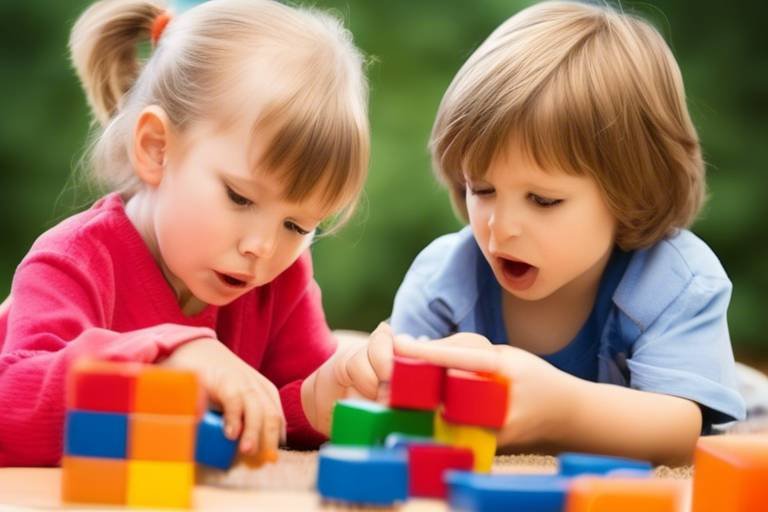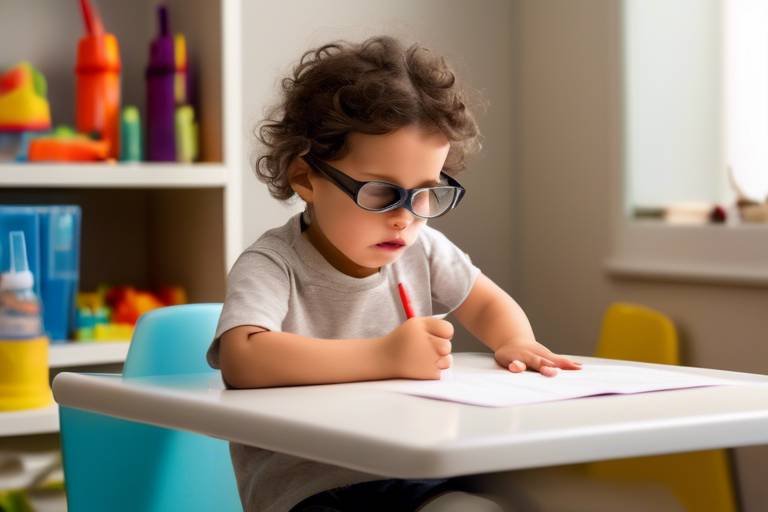The Role of Structured Play in Behavior Modification
Structured play is not just a fun way to pass the time; it is a powerful tool for modifying behavior in both children and adults. Imagine a world where learning occurs naturally through play, where skills are honed not through rote memorization but through engaging activities that captivate the mind and spirit. This article explores how structured play can effectively shape behaviors, enhance social skills, and improve emotional regulation, all while providing a rich tapestry of experiences that foster cognitive development.
At its core, structured play involves organized, purposeful activities designed to promote learning and development. Unlike unstructured play, which allows for free exploration and creativity, structured play is guided by rules, objectives, and often, a facilitator. This distinction is crucial because it allows participants to engage in experiences that are both enjoyable and educational. Think of it as a dance; while the dancers have the freedom to express themselves, they still follow a choreographed routine that brings harmony to the performance.
Structured play can take many forms, from team sports that encourage cooperation to group games that foster communication. Each activity is crafted with specific goals in mind, whether it’s to teach teamwork, enhance problem-solving skills, or even promote emotional intelligence. The beauty of structured play lies in its versatility; it can be adapted for various age groups and settings, making it an invaluable resource for educators, parents, and community leaders alike.
As we dive deeper into the benefits of structured play, it becomes clear that its impact extends far beyond the playground. It serves as a catalyst for personal growth, helping individuals navigate social interactions and emotional challenges. By understanding the role of structured play in behavior modification, we can harness its potential to create more harmonious and productive environments, whether at school, home, or in the community.

Understanding Structured Play
Structured play is an essential concept that encapsulates organized activities aimed at promoting learning and development in both children and adults. Unlike unstructured play, which allows for free exploration and creativity without specific goals, structured play involves a clear framework with defined rules, objectives, and outcomes. Think of it like a well-choreographed dance—each participant knows their role, which allows for a harmonious interaction that can lead to significant learning experiences.
At its core, structured play is designed to foster various skills and behaviors through deliberate engagement. This form of play can take many shapes, from team sports and educational games to guided group activities. The key characteristics that define structured play include:
- Clear Objectives: Each activity is designed with specific learning goals in mind, whether it’s improving social skills or enhancing cognitive abilities.
- Defined Rules: These activities come with established guidelines that help participants understand how to engage with one another and the activity itself.
- Adult Facilitation: Often, structured play involves the guidance of an adult or facilitator who helps steer the activity and ensures that the goals are being met.
Structured play can be thought of as a bridge between the spontaneity of unstructured play and the focused learning environment typical of formal education. It allows individuals to explore their creativity while still adhering to a framework that promotes skill development. For instance, consider a game of soccer. While players have the freedom to express their skills and strategies, the game is governed by rules that promote teamwork, sportsmanship, and communication.
This structured approach to play is not just limited to children; it can also be applied to adults in various settings, such as corporate team-building exercises or community workshops. The principles remain the same—structured play encourages participation, interaction, and learning through engagement, making it a versatile tool for behavior modification across different age groups and environments.
In summary, understanding structured play is crucial for recognizing its potential impact on behavior modification. By providing a controlled environment where individuals can interact, learn, and grow, structured play serves as a powerful mechanism for fostering essential life skills. Whether in a classroom, a sports field, or a community center, structured play opens doors to meaningful interactions and personal development.

Benefits of Structured Play
Engaging in structured play offers a wealth of advantages that extend far beyond mere entertainment. For both children and adults, these organized activities serve as a foundation for essential life skills. Imagine structured play as a well-tended garden; with the right care and attention, it can grow into a lush landscape of social, emotional, and cognitive benefits. By participating in structured play, individuals not only have fun but also cultivate abilities that will serve them throughout their lives.
One of the most significant benefits of structured play is its ability to enhance social skills. When individuals engage in activities that require teamwork and communication, they learn how to interact with others effectively. For example, consider a game of soccer. Not only do players need to communicate about strategies, but they also learn how to cooperate, share, and resolve conflicts that may arise during the game. This kind of interaction fosters a sense of community and belonging, which is crucial for personal development.
Moreover, structured play significantly contributes to emotional regulation. Through guided activities, individuals learn to identify and manage their emotions in a safe environment. For instance, a structured role-playing game allows participants to express their feelings while navigating various scenarios. This practice helps them recognize their emotional responses and develop coping strategies, which are vital for emotional intelligence. When faced with life's challenges, those who have engaged in structured play are often better equipped to handle stress and frustration.
Additionally, structured play promotes cognitive development. Activities that require problem-solving, strategic thinking, and creativity stimulate the brain and encourage critical thinking skills. For example, puzzles and board games are excellent tools for cognitive engagement. They challenge players to think ahead, analyze situations, and make decisions based on available information. This not only enhances cognitive abilities but also prepares individuals for real-world challenges.
| Benefit | Description |
|---|---|
| Social Skills | Enhances communication, cooperation, and conflict resolution through teamwork. |
| Emotional Regulation | Teaches individuals to identify and manage their emotions effectively. |
| Cognitive Development | Stimulates problem-solving, strategic thinking, and creativity. |
In conclusion, the benefits of structured play are multifaceted and significant. By fostering social skills, promoting emotional regulation, and enhancing cognitive development, structured play serves as a powerful tool for personal growth. Whether in educational settings or at home, incorporating structured play into daily routines can lead to profound positive changes. So, why not embrace the power of play? After all, the lessons learned through structured play can last a lifetime!
Social Skills Development
When it comes to structured play, one of the most significant benefits is its ability to enhance social skills among participants. Think about it: when children and adults engage in organized activities, they are not just having fun; they are also learning how to interact with others in a meaningful way. Structured play provides a unique framework where individuals can practice essential social skills in a safe and supportive environment. This is crucial because social skills are the building blocks of successful relationships, both personally and professionally.
Structured play encourages interaction among peers, allowing participants to develop skills such as communication, cooperation, and conflict resolution. For example, when children play team sports, they learn to communicate effectively with teammates, strategize, and work together towards a common goal. This not only fosters a sense of belonging but also teaches them how to express their thoughts and feelings clearly. In this way, structured play acts as a laboratory for social experimentation, where individuals can learn from their interactions.
Moreover, group games designed for structured play can significantly enhance social interactions. These games often require participants to engage with one another, which naturally cultivates relationships and communication skills. Activities like charades or team-building exercises not only make learning fun but also promote a healthy exchange of ideas and feelings among participants. Here are some examples of structured activities that can help in developing social skills:
- Role-Playing Games: These games allow participants to step into different roles, encouraging empathy and understanding of various perspectives.
- Cooperative Board Games: Games that require teamwork and strategy can help players learn to negotiate and collaborate.
- Group Projects: Collaborative tasks in educational settings foster communication and problem-solving skills.
It's important to note that while structured play is beneficial, the effectiveness largely depends on the way activities are facilitated. Educators and parents should aim to create an environment where children feel safe to express themselves and take risks. This means guiding them through the process of resolving conflicts, celebrating successes, and learning from failures. When children see that their emotions and thoughts are valued, they are more likely to engage fully in structured play, leading to better social outcomes.
In summary, structured play is a powerful tool for developing social skills. By participating in organized activities, individuals learn how to communicate, cooperate, and resolve conflicts effectively. The skills acquired through structured play not only benefit children in their formative years but also lay the groundwork for successful social interactions throughout their lives.
Team Sports
When we think about , what often comes to mind are the exhilarating moments of victory, the camaraderie among teammates, and the invaluable lessons learned on and off the field. Team sports, such as soccer, basketball, and volleyball, are more than just games; they are structured play that serves as a powerful tool for behavior modification. By participating in these sports, individuals—especially children—can develop essential social skills, enhance emotional regulation, and foster a sense of community.
One of the most significant benefits of team sports is the opportunity for players to learn the art of communication. Imagine being on a soccer field, where every pass, call, and play requires clear and effective communication. Players must articulate their intentions and listen to their teammates, creating a dynamic environment where collaboration is key. This process teaches individuals how to express their thoughts and feelings, a skill that translates into everyday interactions.
Moreover, team sports inherently promote cooperation. Each player has a role to play, and success hinges on the ability to work together towards a common goal. This shared mission fosters a sense of belonging and teamwork, which is crucial for building relationships. For instance, in a basketball game, players must not only focus on their individual performance but also support their teammates, whether that means setting a screen, making an assist, or encouraging someone who missed a shot. Such experiences cultivate a strong sense of unity and trust among players.
Conflict resolution is another critical aspect of team sports. Disagreements are bound to arise, whether it's about a missed play or a difference in strategy. However, navigating these conflicts in a structured environment teaches players how to address issues constructively. Instead of resorting to frustration or resentment, they learn to communicate openly, listen to differing viewpoints, and find common ground. This ability to resolve conflicts amicably is an invaluable life skill that extends far beyond the playing field.
In addition to social skills, team sports also play a vital role in emotional regulation. The highs and lows of competition can be intense, and learning to manage these emotions is crucial. For example, a player may feel the rush of excitement after scoring a goal, but they also need to handle the disappointment of losing a game. Through structured play, individuals learn to recognize their emotions, understand their triggers, and develop coping strategies. This emotional awareness not only enhances their performance in sports but also improves their overall mental health.
To sum it up, team sports are a remarkable form of structured play that offers a wealth of benefits. They provide a platform for developing social skills, enhancing emotional regulation, and fostering teamwork. Whether it’s through the thrill of a last-minute goal or the support of a teammate during tough times, the lessons learned on the field can shape individuals into well-rounded, socially adept, and emotionally resilient people.
As we explore the broader implications of structured play, it’s essential to recognize the profound impact that team sports can have on personal development. They are not just games; they are a microcosm of life, where individuals learn to navigate relationships, manage emotions, and work collaboratively towards shared objectives.
- What are the benefits of team sports for children?
Team sports help children develop social skills, emotional regulation, and teamwork abilities, which are essential for their overall growth. - How can parents encourage their children to participate in team sports?
Parents can encourage participation by introducing their children to various sports, attending games, and being supportive of their involvement. - Are team sports suitable for all ages?
Yes, team sports can be adapted for various age groups, making them suitable for both children and adults.
Group Games
Group games serve as a fantastic avenue for structured play, providing participants with opportunities to engage in social interactions while having fun. These games are not just about competition; they are about collaboration, communication, and building relationships. Imagine a group of children huddled together, strategizing their next move in a game of capture the flag. The excitement in the air is palpable, and within that excitement lies a treasure trove of social learning. Group games can vary widely, from traditional sports to creative team-building exercises, but they all share a common goal: to foster connection.
One of the beautiful aspects of group games is their ability to teach essential social skills in a natural setting. For instance, consider games like charades or Simon Says. These games require players to communicate effectively and understand non-verbal cues, which are crucial components of social interaction. When players take turns guessing or following commands, they learn to listen actively, express themselves clearly, and respect others' contributions. This back-and-forth interaction mirrors real-life conversations and can significantly enhance interpersonal skills.
Moreover, group games can also serve as a platform for conflict resolution. When disagreements arise—whether it’s about the rules of the game or the outcome—participants must navigate these conflicts constructively. This process teaches them how to compromise, negotiate, and find common ground. For example, in a game of soccer, if two players argue over who should take a penalty kick, they must discuss their perspectives and come to an agreement. This experience not only helps them resolve the current issue but also equips them with skills to handle future conflicts in a healthy manner.
To illustrate the impact of group games on social skills, let’s take a look at a few examples:
| Game | Social Skill Developed |
|---|---|
| Team Sports (e.g., basketball, soccer) | Teamwork and Cooperation |
| Board Games (e.g., Monopoly, Settlers of Catan) | Strategic Thinking and Negotiation |
| Role-Playing Games (e.g., Dungeons & Dragons) | Empathy and Perspective-Taking |
In addition to enhancing social skills, group games also promote inclusivity. They create an environment where everyone has a role to play, regardless of their individual abilities. Whether someone is a star athlete or a beginner, there’s always a spot for them in the game. This inclusivity not only boosts self-esteem but also fosters a sense of belonging among participants. It’s a reminder that everyone can contribute to the group's success, much like a puzzle where each piece is vital to completing the picture.
Ultimately, the beauty of group games lies in their ability to combine fun with learning. They are a powerful tool for behavior modification, as they encourage positive interactions and teach valuable life skills. So, the next time you see a group of people engaged in play, remember that they are not just having fun; they are building the foundations of effective communication, teamwork, and emotional intelligence.
Emotional Regulation
Emotional regulation is a vital skill that allows individuals to manage their feelings and reactions effectively. In the context of structured play, this skill can be nurtured through various activities that encourage participants to recognize their emotions and respond to them in constructive ways. Imagine a child playing a game where they must take turns; this simple act can teach patience and help them understand the frustration that comes with waiting. Not only does structured play provide a framework for learning these skills, but it also creates a safe space for individuals to express their emotions without fear of judgment.
One of the most impactful ways structured play aids in emotional regulation is through role-playing scenarios. These activities allow participants to step into different roles, enabling them to explore various emotional responses in a controlled environment. For instance, a child might role-play as a teacher while their peers act as students. This setup can lead to discussions about feelings related to authority, responsibility, and empathy. By navigating these scenarios, individuals can practice emotional awareness and develop strategies to cope with different feelings.
Furthermore, structured play often incorporates elements of storytelling, which can be a powerful tool for emotional expression. When participants engage in storytelling, they not only share their experiences but also learn to articulate their feelings. This process can be incredibly beneficial for children who may struggle to express themselves verbally. Through guided storytelling activities, they can learn to identify emotions, understand their origins, and discuss them openly, fostering a deeper sense of emotional intelligence.
In addition, structured play can employ techniques such as mindfulness and breathing exercises. These practices help individuals become more aware of their emotional states and develop the ability to regulate their responses. For example, before starting a game, a facilitator might lead a short mindfulness session, encouraging participants to focus on their breathing and acknowledge their feelings. This practice can create a calm atmosphere, allowing individuals to approach the game with a clearer mind and better emotional control.
To further illustrate the connection between structured play and emotional regulation, consider the following table that outlines specific activities and their emotional benefits:
| Activity | Emotional Benefits |
|---|---|
| Role-Playing | Enhances empathy and understanding of different perspectives. |
| Storytelling | Encourages emotional expression and vocabulary development. |
| Mindfulness Games | Promotes relaxation and awareness of emotional states. |
| Team Challenges | Teaches cooperation and conflict resolution skills. |
In conclusion, structured play is not just about having fun; it’s an essential avenue for developing emotional regulation skills. By engaging in thoughtfully designed activities, individuals can learn to navigate their emotions more effectively, leading to healthier interactions and improved overall well-being.
- What is emotional regulation? Emotional regulation refers to the ability to manage and respond to emotional experiences in a healthy way.
- How does structured play help with emotional regulation? Structured play provides a safe environment where individuals can practice recognizing and expressing their emotions, leading to better emotional control.
- Can adults benefit from structured play? Absolutely! Structured play can be beneficial for individuals of all ages, helping them to enhance their emotional intelligence and social skills.
- What types of structured play are best for emotional regulation? Activities like role-playing, storytelling, and mindfulness games are particularly effective in promoting emotional awareness and regulation.

Implementing Structured Play in Educational Settings
Incorporating structured play into educational environments is not just a trend; it's a transformative approach that can significantly enhance learning experiences for children. When we think of education, we often picture rigid classrooms filled with desks and textbooks. However, by embracing structured play, educators can create dynamic learning environments that foster creativity, critical thinking, and collaboration among students. But how can teachers effectively implement this approach in their classrooms? Let's explore some strategies.
First and foremost, curriculum integration is key. Educators can seamlessly blend structured play with educational objectives by designing activities that align with learning goals. For instance, a math lesson can involve a game where students use dice to practice addition and subtraction. This not only makes learning fun but also reinforces mathematical concepts in a practical context. By integrating play into the curriculum, teachers can capture students' attention and make lessons more engaging.
Another crucial aspect is creating a play-friendly environment. Classrooms should be designed to encourage movement and interaction. This could mean rearranging furniture to create open spaces for group activities or incorporating various materials like blocks, art supplies, and games that promote structured play. The ambiance of the classroom can have a significant impact on students’ willingness to engage in structured play. A vibrant, welcoming space can spark curiosity and excitement, inviting students to explore and collaborate.
Moreover, educators should consider the diverse needs of their students when implementing structured play. Not all children learn the same way, and some may thrive in more structured environments than others. By offering a variety of activities, teachers can cater to different learning styles. For example, while some students may enjoy team sports, others might prefer creative projects or problem-solving games. This diversity allows every child to find their niche, promoting inclusivity and ensuring that all students benefit from structured play.
Finally, ongoing assessment and feedback are essential components of implementing structured play in educational settings. Teachers should regularly evaluate how these activities are impacting student learning and behavior. This can be done through informal observations or structured assessments that measure social skills, emotional regulation, and cognitive development. By understanding what works and what doesn’t, educators can refine their approaches and ensure that structured play remains a valuable part of their teaching strategy.
- What is structured play? Structured play refers to organized activities that promote learning and development, often guided by an adult.
- How does structured play benefit children? It enhances social skills, improves emotional regulation, and fosters cognitive development.
- Can structured play be integrated into any subject? Yes, structured play can be tailored to fit various subjects and learning objectives, making it versatile for educators.
- What role do parents play in structured play? Parents can support structured play by engaging in activities with their children, reinforcing the skills learned in educational settings.
Curriculum Integration
Integrating structured play into the curriculum can transform the educational landscape, making learning not only more engaging but also more effective. Imagine a classroom where students are not just passive recipients of information, but active participants in their learning journey. This approach encourages educators to blend traditional teaching methods with playful activities that promote critical thinking and problem-solving skills. By doing so, teachers can create a dynamic learning environment that caters to diverse learning styles and needs.
One effective way to integrate structured play into the curriculum is through project-based learning. This method allows students to work on real-world projects that require collaboration, creativity, and critical thinking. For instance, a science class might involve students building a model of a sustainable ecosystem. As they engage in this structured play, they not only learn about ecological concepts but also develop teamwork and communication skills. Such hands-on activities encourage students to apply theoretical knowledge in practical settings, reinforcing their understanding and retention.
Additionally, educators can incorporate structured play through thematic units, where subjects are interconnected around a central theme. For example, a unit on “community” could involve students engaging in role-playing activities that simulate local governance or community service projects. This not only enhances their understanding of social studies but also fosters empathy and social responsibility. The key is to ensure that these activities are well-planned and aligned with learning objectives, providing a clear educational purpose while allowing for creativity and exploration.
Moreover, the use of technology can further enhance the integration of structured play in the curriculum. Interactive games and simulations can provide students with opportunities to experiment and explore concepts in a virtual environment. For example, a math lesson could incorporate a game where students solve problems to progress through levels, making learning fun and competitive. However, it’s essential to balance screen time with physical activities to ensure a holistic approach to education.
Creating a curriculum that embraces structured play also requires support from the entire educational community, including administrators and parents. Professional development for teachers is crucial, equipping them with the skills and knowledge to implement these strategies effectively. Furthermore, involving parents in the process can create a supportive home environment that reinforces the benefits of structured play. Schools can host workshops to educate parents on how to engage their children in playful learning activities at home, creating a partnership that extends learning beyond the classroom.
In conclusion, integrating structured play into the curriculum not only enriches the educational experience but also prepares students for real-world challenges. By adopting a playful approach to learning, educators can cultivate a classroom atmosphere that encourages exploration, collaboration, and creativity. This shift in perspective can lead to significant improvements in student engagement and achievement, ultimately shaping well-rounded individuals ready to tackle the complexities of the world.
Creating a Play-Friendly Environment
Establishing a play-friendly environment is crucial for maximizing the benefits of structured play. Think of it as setting the stage for a captivating performance; the right backdrop can make all the difference in how the play unfolds. A well-designed space not only encourages participation but also fosters creativity and exploration. So, what does a play-friendly environment look like? Let's dive in!
First and foremost, space matters. A dedicated area for play should be spacious enough to accommodate various activities without feeling cramped. This could be an indoor playroom or an outdoor playground. The layout should allow for both group activities and individual play, catering to different preferences and social dynamics. For instance, consider creating zones within the play area: a quiet corner for solitary play, a collaborative space for group games, and an open area for physical activities. This zoning can help children navigate their play experiences more effectively.
Next, the materials and resources available in the play area should be diverse and engaging. Incorporating a variety of toys, games, and equipment can stimulate different types of play. For example, you might include:
- Art supplies for creative expression
- Building blocks or construction sets for imaginative play
- Sports equipment to promote physical activity
- Puzzles and board games for cognitive challenges
Having a mix of resources encourages children to explore their interests and develop new skills. Additionally, rotating materials regularly can keep the environment fresh and exciting, preventing boredom.
Furthermore, the environment should be safe and accessible. Safety measures are paramount; ensure that all play equipment is age-appropriate and regularly inspected for hazards. Accessibility is equally important; consider the needs of all children, including those with disabilities. Creating an inclusive space where everyone can participate is essential for fostering a sense of belonging and community.
Another key element is the involvement of adults. Caregivers and educators should actively engage in the play process, guiding and facilitating without taking control. This involvement can help children learn to navigate social interactions and develop problem-solving skills. Adults can also model positive behaviors, demonstrating how to share, cooperate, and resolve conflicts. Think of them as directors in a play, subtly guiding the action while allowing the performers to shine.
Lastly, it’s vital to cultivate a positive atmosphere. This involves not only the physical space but also the emotional environment. Encourage positive interactions among children by promoting kindness and respect. Simple practices like praising efforts, celebrating achievements, and providing constructive feedback can significantly enhance the emotional experience of play. When children feel supported and valued, they are more likely to engage wholeheartedly in structured play.
In summary, creating a play-friendly environment is about more than just setting up a space; it's about crafting an experience that nurtures growth, learning, and connection. By focusing on space, resources, safety, adult involvement, and emotional atmosphere, we can create a vibrant setting where structured play can flourish.
- What is structured play? Structured play refers to organized activities that promote learning and development through guided interactions.
- How can I create a play-friendly environment at home? Ensure you have a designated play area with diverse materials, maintain safety standards, and engage with your children during play.
- Can structured play benefit adults as well? Absolutely! Structured play can enhance teamwork, communication, and stress relief for adults in various settings.

Challenges in Structured Play
While structured play is a powerful tool for behavior modification, it does come with its own set of challenges. Understanding these obstacles is crucial for educators, parents, and caregivers who wish to implement structured play effectively. One of the primary challenges is balancing structure and freedom. Too much structure can stifle creativity, while too little can lead to chaos and disengagement. Finding that sweet spot where children can explore their imagination while still benefiting from guided activities is essential. This balance can be likened to walking a tightrope; a little sway in either direction can lead to a fall.
Another significant challenge is parental involvement. Parents are often the first teachers in a child's life, and their engagement in structured play can dramatically influence its effectiveness. However, busy schedules and differing parenting philosophies can hinder this involvement. It’s crucial for parents to understand the importance of their role in structured play. They should be encouraged to participate actively, not just as spectators, but as facilitators of the experience. This means getting down on the floor to play, guiding children through activities, and showing enthusiasm for the structured play sessions.
Additionally, there are environmental factors that can impede structured play. For example, a lack of appropriate space or resources can limit the types of activities that can be offered. Schools and community centers often struggle with budget constraints that affect their ability to provide the necessary materials and safe spaces for play. In such cases, creativity becomes essential. Educators and parents can utilize everyday items in innovative ways to create engaging structured play experiences. For instance, a simple cardboard box can become a spaceship, a castle, or a race car, depending on how it's used.
To address these challenges, it’s important to develop a clear strategy that includes:
- Regular communication between parents and educators to ensure everyone is on the same page regarding the goals of structured play.
- Training for educators on how to effectively implement structured play without losing the essence of fun and creativity.
- Creating a resource-sharing community where parents and educators can exchange ideas and materials for structured play.
In conclusion, while there are challenges in implementing structured play, the potential benefits far outweigh the difficulties. By fostering a collaborative environment and being mindful of the balance between structure and freedom, we can create enriching play experiences that promote positive behavior modification in both children and adults.
Q: What is structured play?
A: Structured play refers to organized activities designed to promote learning and development. It often involves specific rules and goals, distinguishing it from unstructured play, which is more free-form.
Q: How can structured play benefit children?
A: Structured play can enhance social skills, improve emotional regulation, and foster cognitive development, making it an essential part of childhood learning.
Q: What are some examples of structured play activities?
A: Examples include team sports, group games, and educational activities that involve clear objectives and rules.
Q: How can parents support structured play?
A: Parents can engage in structured play by participating in activities, encouraging their children, and providing a supportive environment that fosters play.
Balancing Structure and Freedom
Finding the right balance between structure and freedom in structured play is crucial for fostering creativity and ensuring that individuals can thrive in their learning environments. Too much structure can stifle creativity, while too much freedom can lead to chaos and a lack of focus. It’s like trying to cook a perfect dish; you need the right amount of ingredients, timing, and technique to create something delicious. So, how do we strike this balance?
One effective approach is to incorporate flexible guidelines within structured play activities. This means setting clear objectives and rules while allowing participants the freedom to express themselves and make choices. For instance, in a team sport, coaches can establish the rules of the game but encourage players to come up with their own strategies and plays. This not only enhances their understanding of the game but also nurtures their ability to think critically and creatively.
Moreover, it’s essential to observe how participants respond to different levels of structure. Some individuals may thrive under more guidance, while others may excel when given the freedom to explore. Regularly assessing the needs and preferences of the participants can help in adjusting the level of structure accordingly. This could involve conducting informal surveys or simply having conversations to gauge their comfort levels and engagement.
Another key aspect is to create an environment that encourages exploration and innovation. This can be achieved by providing a variety of materials and resources that participants can use in their play. For example, if children are engaged in a structured art activity, offering them different types of paint, brushes, and canvases allows them to explore their creativity while still being guided by the overall objective of the project.
In addition, incorporating reflection time into structured play can help participants process their experiences and learn from them. After an activity, discussing what worked well and what didn’t can foster a deeper understanding of the balance between structure and freedom. This reflection can lead to improved future performances, whether in sports, games, or any other structured play activities.
Ultimately, the goal is to create a play environment that is both engaging and educational. By carefully balancing structure and freedom, we can help participants develop essential skills while also allowing them to express their individuality. Remember, structured play is not just about following rules but also about discovering the joy of learning through play.
- What is structured play? Structured play refers to organized activities designed to promote learning and development, often with specific goals and guidelines.
- How can I balance structure and freedom in play? By setting clear objectives while allowing flexibility for creativity and exploration, and regularly assessing participant needs.
- What are some examples of structured play? Team sports, group games, and educational activities that have defined rules and goals.
- Why is parental involvement important in structured play? Parents can provide support, encouragement, and guidance, enhancing the overall experience and learning outcomes for children.
Parental Involvement
When it comes to structured play, parental involvement is not just beneficial; it's absolutely essential. Parents play a pivotal role in guiding their children's experiences and ensuring that these activities are both enjoyable and educational. Imagine structured play as a dance; while children are the dancers, parents are the choreographers, helping to shape the movements and flow of the performance. Their participation can significantly enhance the outcomes of these activities, transforming them into powerful tools for development.
One of the key aspects of parental involvement is the ability to model appropriate behaviors during play. When parents actively engage in structured activities, they demonstrate essential skills such as communication, cooperation, and problem-solving. For instance, during a game of soccer, a parent can show their child how to effectively communicate with teammates, emphasizing the importance of clear instructions and encouragement. This not only enhances the child's understanding of the game but also reinforces positive social interactions.
Moreover, parents can facilitate structured play by organizing playdates or group activities that encourage collaboration among peers. These interactions are crucial for developing social skills, and parents can take the lead by setting up scenarios that require teamwork. For example, they might organize a neighborhood scavenger hunt, where children must work together to solve clues and find hidden treasures. This type of engagement fosters a sense of community and strengthens relationships among children.
It’s also important for parents to be aware of their children's emotional needs during structured play. By observing their child's reactions and providing support when necessary, parents can help children navigate their feelings. For instance, if a child becomes frustrated during a board game, a parent can step in to offer encouragement or suggest a break, teaching the child how to manage emotions effectively. This kind of emotional coaching is invaluable, as it helps children develop resilience and emotional intelligence.
However, it’s crucial to strike a balance. While parental involvement is important, parents should also allow children the space to explore and engage in play independently. Over-involvement can lead to feelings of pressure or anxiety in children, which can undermine the very benefits that structured play aims to provide. Thus, parents should aim to be supportive without overshadowing their child's experience. This balance can be achieved by participating in play but also stepping back to allow children to lead the way.
In conclusion, parental involvement in structured play is a multifaceted endeavor that can significantly enhance a child's development. By modeling positive behaviors, organizing collaborative activities, and providing emotional support, parents can create a rich environment that fosters learning and growth. Just as a gardener nurtures plants to help them flourish, parents can cultivate their children's skills through active engagement in structured play, ensuring they blossom into well-rounded individuals.
- What is structured play? Structured play refers to organized activities that promote learning and development through specific rules and objectives.
- How can parents get involved in structured play? Parents can participate by modeling behaviors, organizing activities, and providing emotional support during play.
- What are the benefits of structured play? Structured play enhances social skills, emotional regulation, and cognitive development among children and adults.
- Can structured play be beneficial for adults? Absolutely! Structured play can help adults improve teamwork, communication skills, and stress management.
Frequently Asked Questions
-
What is structured play?
Structured play refers to organized activities designed to foster learning and development. Unlike unstructured play, which is spontaneous and freeform, structured play has specific rules and objectives that guide participants toward achieving particular skills or outcomes.
-
How does structured play benefit social skills development?
Structured play promotes interaction among peers, allowing individuals to practice essential social skills like communication, cooperation, and conflict resolution. Activities such as team sports and group games create opportunities for participants to engage, collaborate, and learn how to navigate social dynamics effectively.
-
Can structured play help with emotional regulation?
Absolutely! Structured play provides a safe environment for individuals to explore and manage their emotions. Through various activities, participants can learn to recognize their feelings, express them appropriately, and develop coping strategies for emotional challenges.
-
How can educators implement structured play in the classroom?
Educators can integrate structured play into their curriculum by designing activities that align with educational objectives. This can include incorporating games that teach specific concepts or skills while keeping learning engaging and interactive.
-
What are some challenges associated with structured play?
While structured play has many benefits, challenges can arise, such as finding the right balance between structure and freedom. It's important to allow for creativity and spontaneity while maintaining enough guidance to ensure the intended learning outcomes are achieved.
-
How can parents support structured play at home?
Parents can actively engage in structured play by organizing activities that promote learning and development. This could involve playing educational games, encouraging teamwork through sports, or setting up playdates that focus on structured activities to enhance social skills.



















